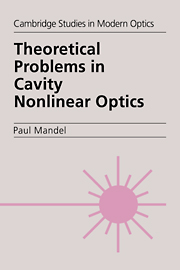Book contents
- Frontmatter
- Contents
- Introduction
- 1 Reduction of the Maxwell–Schrödinger equations
- 2 Parameter swept across a steady bifurcation I
- 3 Parameter swept across a steady bifurcation II
- 4 Optical bistability: Constant input
- 5 Optical bistability: Variable input
- 6 Multimode optical bistability
- 7 Free-running multimode lasers
- 8 Antiphase dynamics
- 9 Laser stability
- 10 Second harmonic generation
- 11 Saturable absorbers
- 12 Transverse effects in optical bistability
- Index
10 - Second harmonic generation
Published online by Cambridge University Press: 16 October 2009
- Frontmatter
- Contents
- Introduction
- 1 Reduction of the Maxwell–Schrödinger equations
- 2 Parameter swept across a steady bifurcation I
- 3 Parameter swept across a steady bifurcation II
- 4 Optical bistability: Constant input
- 5 Optical bistability: Variable input
- 6 Multimode optical bistability
- 7 Free-running multimode lasers
- 8 Antiphase dynamics
- 9 Laser stability
- 10 Second harmonic generation
- 11 Saturable absorbers
- 12 Transverse effects in optical bistability
- Index
Summary
Introduction
Up to now, we have described in detail many properties of steady bifurcations and limit points, that is, critical points where a stable steady state solution loses its stability and coincides with another steady state solution. At a few places, we have also met the so-called Hopf bifurcation where a steady solution loses its stability and a time-periodic solution emerges. However, we have not yet studied in any detail a Hopf bifurcation for lack of a suitable example. Even the simple-looking trio of laser equations on resonance [equations (1.58)–(1.60) with Δ = 0, E and P real] yield such complex expressions that it is hard to separate conceptual difficulties from mere computational problems. In this chapter, we make an intrusion upon a domain that has not yet been considered in this book. The motivation is both to cover an important topic of cavity nonlinear optics and to provide a pedagogical example of a Hopf bifurcation.
In the preceding chapters, this book has dealt exclusively with processes in which only one photon is either absorbed or emitted. Other phenomena, however, rely on multiphoton transitions [1, 2]. In the original Bohr formulation of atomic transitions and in much of the ensuing quantum mechanical formulation, resonance conditions on atomic transitions express conservation laws but give no constraint on the number of photons needed to achieve the transition.
- Type
- Chapter
- Information
- Theoretical Problems in Cavity Nonlinear Optics , pp. 124 - 139Publisher: Cambridge University PressPrint publication year: 1997



